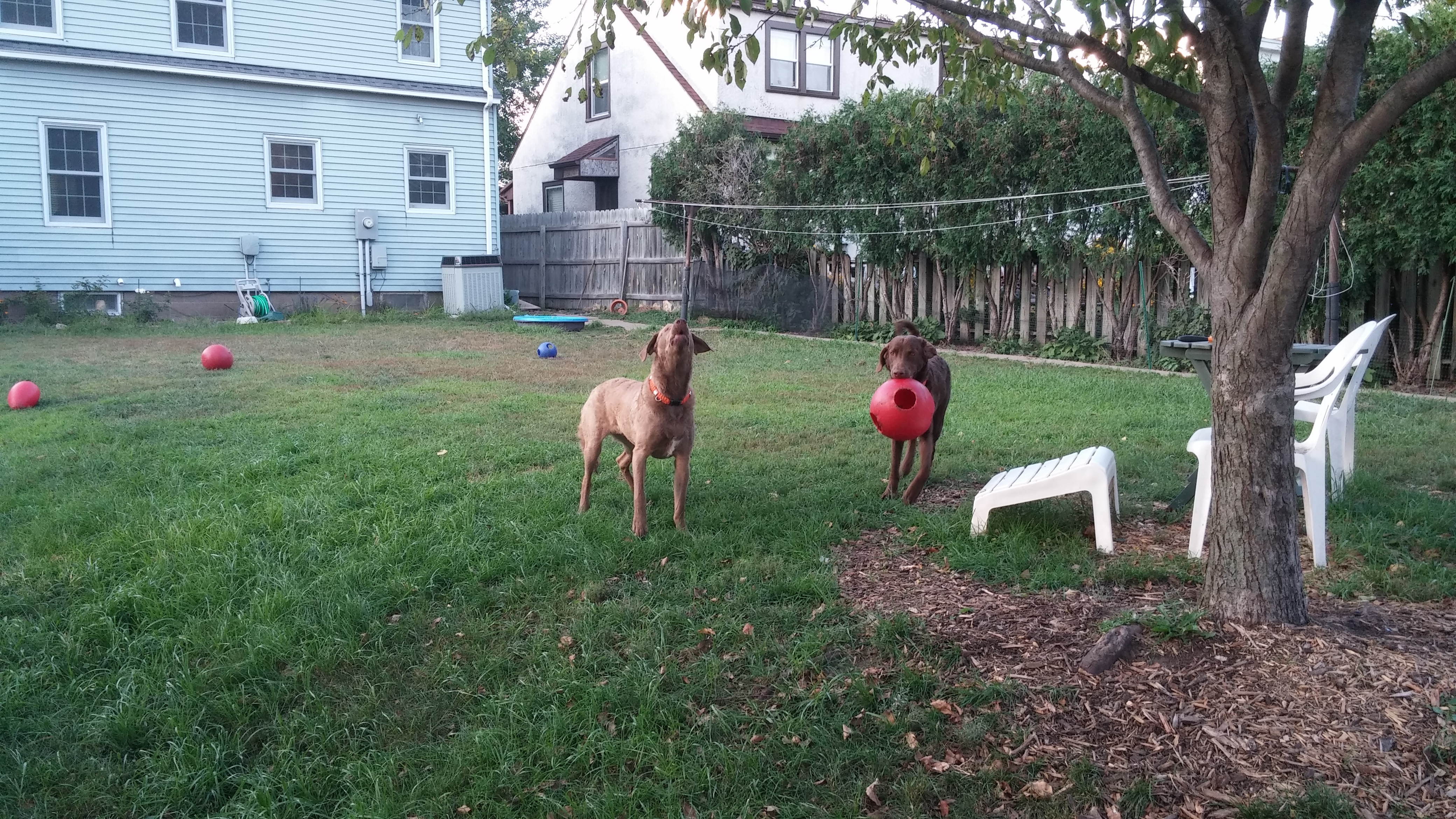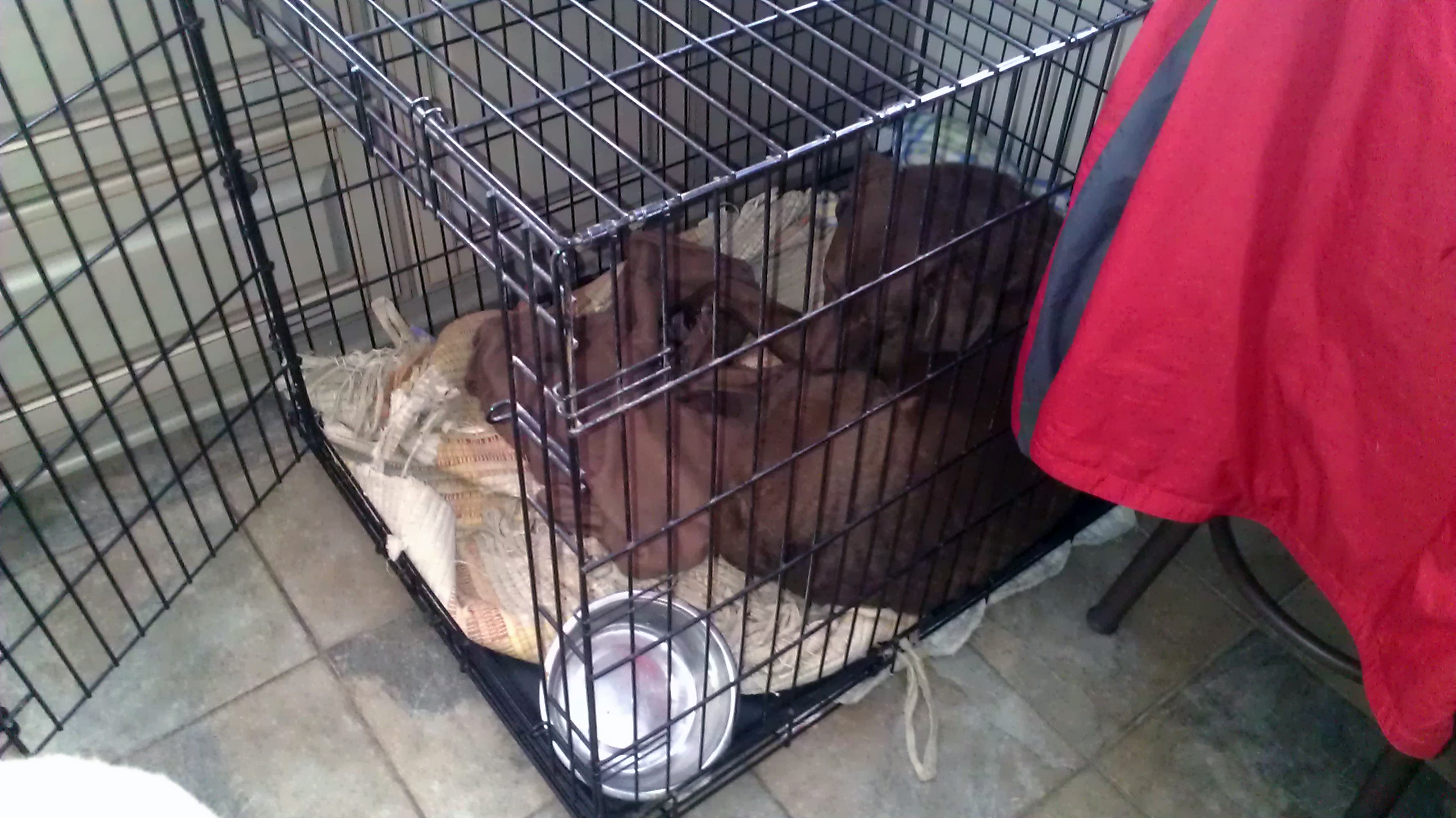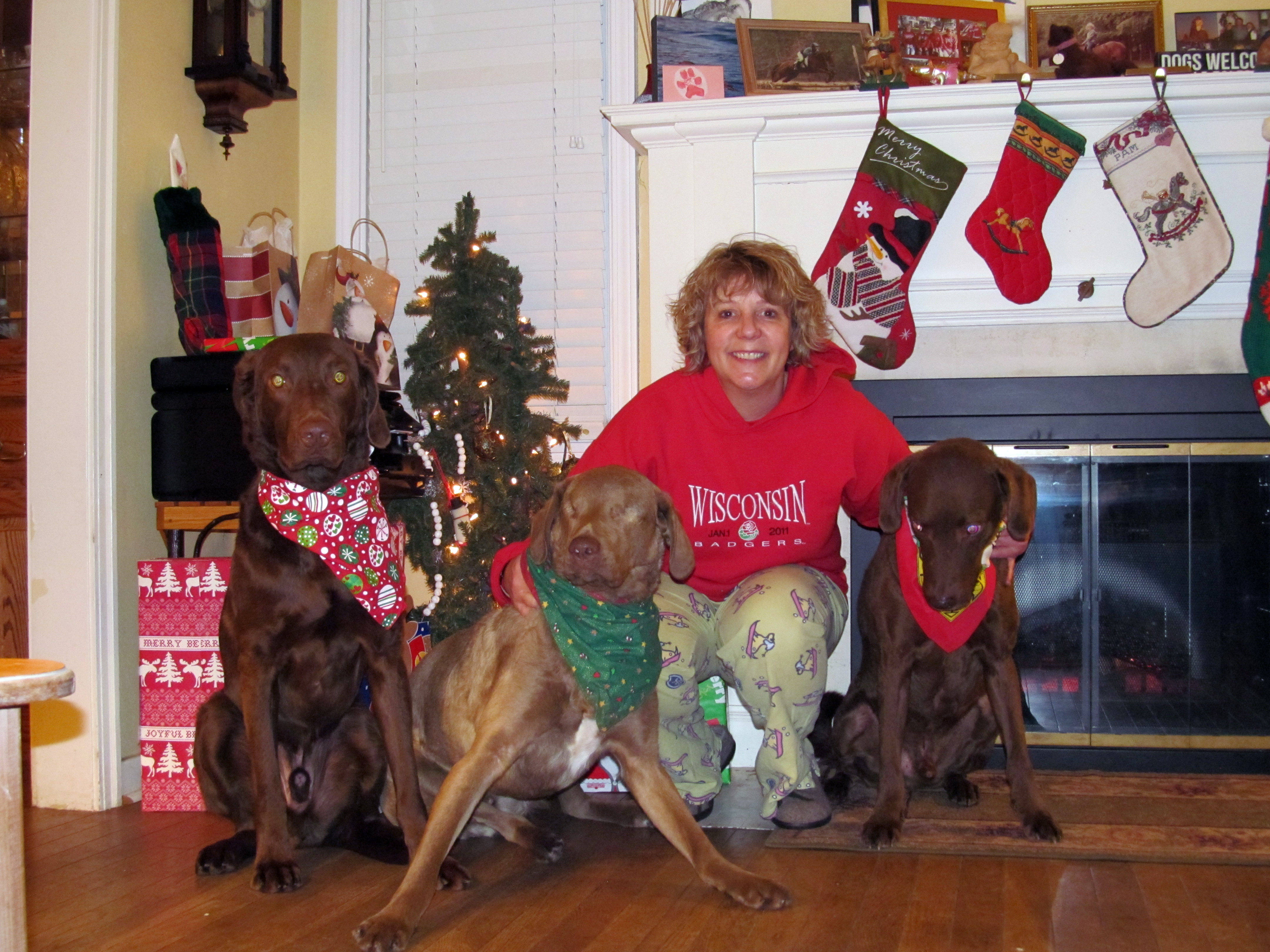When Louie arrived at my house, he would run around the house barking and howling at any noise – not even loud ones. This was an extremely fearful dog and I was at a loss how to deal with him. Here are some of the methods I tried, some of them have worked for Louie and some did not, that doesn’t mean they won’t work for your fearful or anxious dog.
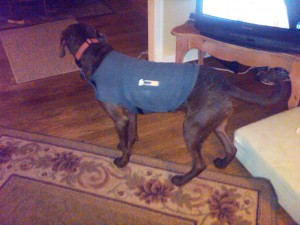
Thundershirt – Upon recommendation, we got a Thundershirt to try. We tried the Thundershirt and had some success and would definitely recommend people start there. We also enrolled in some obedience classes and he does pretty well with those. Louie also does agility and is my running partner. All of these efforts were good to a point but I found it was just difficult to keep Louie’s attention and to get or keep him focused on me as he was constantly searching for his next fear.
Anxiety Medication
After several discussions with the vet, behaviorist and other trainers, we decided to try anxiety drugs. Louie takes 40 mg of fluoxetine which is a human generic of Prozac. Fluoxetine is a daily serotonin inhibitor, not a sedative that can be given sometimes. This is an important difference as fluoxetine cannot be given sporatically or when needed. It MUST be given DAILY. It takes 6-8 weeks before you may see the full effect of the drug. Fluoxetine is simply a tool in the box; it is not a cure; it is not to be used alone. In addition to fluoxetine, I continue many other strategies. Here is an excerpt from VetInfo.com about fluoxetine. I encourage you to not only read this excerpt but also read the side effects and determine what other behavior modification strategies you will use with the fluoxetine.
“Behavioral medication is usually prescribed in conjunction with a behavior modification program. Often once anxiety or fear levels drop, dogs are more capable of learning skills to help them cope with the triggers to their anxiety. Because of this, fluoxetine is often prescribed for short-term use until the behavior modification program is showing progress. Other dogs might not be able to function without the drug and may take it indefinitely.
Usually, veterinarians will start your dog on a dosage much smaller than the dog needs and gradually increase. A sudden increase or decrease in the drug can cause severe behavior changes in your dog, so these must be done with caution. If you decide to discontinue use of fluoxetine, be sure to gradually decrease the usage. It usually takes six to eight weeks before the drug can be determined ineffective.”
(Read more: The Side Effects of Fluoxetine for Dog Behavior Treatment on VetInfo http://www.vetinfo.com/fluoxetine-dogs-behavior.html)
I have not tried sedatives as I do not believe they would be beneficial in Louie’s situation as his anxieties are not situational, they are all of the time.
Other Behavior Modification Strategies for Fearful Dogs
These are the strategies I am using in conjunction with the fluoxetine with Louie. These can be used effectively alone or together. I have used them with other less severe anxiety cases or even with dogs that have one or two specific fears.
Exercise
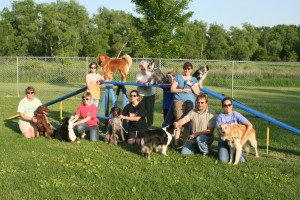
It is important to pair medication with obedience training and exercise. I found a great trainer at our local humane society that works with me and is very supportive of Louie’s issues and finding possible solutions. We have done obedience classes and he was great. We moved into a social skills class with a reoccurring group dog handling teams which is great because they know Louie and he has really made great strides surrounded by people who understand him and provide him with mental challenges in a safe environment. We also do agility which Louie LOVES. Unfortunately this is only available in the summer. I also walk or run with Louie daily. Exercise is an important component of his daily routine.
Classical music
I keep a radio next to Louie’s crate tuned to a classical music (NPR) station and it is ALWAYS on. Classical music has been proven to calm shelter and anxiety dogs and I have found it works with Louie. I have tried other types of music but have found that not only with Louie but my other dogs, classical music is by far the most soothing. Louie’s radio is always on but I also turn a second radio on in a different room for my other dogs (one is blind and currently I have an anxious foster) they also find comfort and are calmer once the classical music is playing. I recently found that my foster dog is a very anxious passenger in the car. I have tried the Thundershirt, stuffed Kong, crate and nothing has worked. The other day I tuned the radio to our normal classical station and he seemed a bit calmer. I will now be listening to classical music when he is in the car.
Classical Conditioning, Counterconditioning and Desensitization
One of the best online resources I have found on this topic is Fearfuldogs.com and Debbie Jacobs (www.fearfuldogs.com). Here is a description from her page of these three training strategies:
“Classical Conditioning: Think Pavlov. The bell rings and food appears. Eventually the bell rings and the dog thinks food and with time the dog’s body learns to react appropriately (drools). Even if the bell rings and no food appears, the dog will drool. Use this technique as the main technique for teaching your dog that scary things and situations mean good things (high value treats & rewards). Classical conditioning is also used to create positive associations with whatever you think is important for your dog to like (coming when called, being touched, sitting, being brushed, having their ears looked at, feet handled, being bathed, etc.).
Counter Conditioning: This is basically using classical conditioning to change your dog’s feelings or response to something it fears. You are creating positive associations and the dog begins to feel happy or excited, or calm about things that previously caused it to feel fear. It takes time and repetition.
Desensitizing: By repeatedly exposing your dog to a trigger, at an intensity which the dog does not find scary, and having nothing bad occur, your dog ultimately becomes used to it. If the dog is afraid of a running vacuum cleaner you start slow and first desensitize your dog to the vacuum being in the room turned off, then you might move it around the room without turning it on. It will take many exposures for the dog to become desensitized to something. Combine counter conditioning and desensitizing.”
Read more about these techniques, Debbie’s book “Living with a Fearful Dog” and access to videos at http://fearfuldogs.com/getting-started-with-a-fearful-dog/
There is also a series of CD’s called “Through a Dog’s Ears” (http://throughadogsear.com/) that intersperse commonly feared noises within the classical music. I have used this with great success. Again it is a long slow classical conditioning process as I also provide wonderful treats during firework celebrations and thunderstorms. When the environment gets noisy the BEST treats come out and these are the treats that are saved for noise only and Louie LOVES them! He will do back flips for frozen liver strips. I do not cuddle or baby, I bring out the treats and we have a party! So I may fill a Kong with frozen liver bites and banana or peanut butter if I have to leave or if not we will sit on the floor with classical music playing and play games with HUGE frequent rewards of liver. I have not had any success with the rescue remedy or the calming collars, sprays. This year on New Year’s Even during the fireworks, Louie jumped in bed with me and curled up against my legs and was snoring before the fireworks were over! That was his 3rd New Year’s Eve with me! The first two were pretty ugly. This is a long process but very doable with some time, dedication and patience.
We may have made progress with thunderstorms and fireworks but skateboards and bicycles are very problematic since I live in Wisconsin and we only see them for 6-7 months per year. By the time, he is used to bicycles and not reacting, they go away for the winter and cross country skis come out! Then in 5-6 months the skis go away and the bikes come back out! I am hoping each year our adjustment periods will become shorter but I have to carry a pocket full of yummy treats and always be on the look out!
Thresholds
The threshold is the point of exposure to the feared item where your dog can no longer deal with it before reacting in a negative way (with fear or aggression). So you not only need to know what your dog is afraid of (triggers) but also how much exposure they can take. Once a fearful dog exceeds their threshold, it is too late and you cannot make positive progress. (Read more about thresholds in “Across a Threshold” by Mardi Richmond, MA, CPDT-KA in The Whole Dog Journal, http://www.whole-dog-journal.com/issues/16_4/features/across-a-threshold_20726-1.html?s=FB051714)
Fearful Dog’s Body Language –
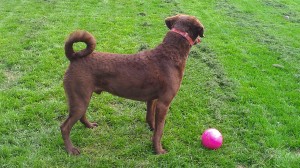
It is helpful to learn your dog’s “fear body language”. What does their body do when they begin to see or hear something that causes them anxiety? Do their pupils dilate? Do they start drooling, lowered ears, cower, flee, does their tail set change? What is it that you see prior to your fearful dog reacting or reaching threshold?
Louie’s pupils will be dilated almost the entire time we are walking on leash so while that is a cue that he is anxious, it is not an indicator of him about to launch or near his threshold. If you look at Louie’s early pictures, his tail is always curled tightly like a pig’s tail. In the last year, Louie’s tail has begun to straighten and hang lower.

His tail has now become a great barometer for me tell when he is really close to threshold but I have a few seconds to catch him before he reaches his threshold.
Desensitizing and Counter Conditioning
Desensitizing and Counterconditioning requires you to retrain your dog that the trigger (item or thing he fears) is now a good thing. This is a long slow process so do not think this can be done in weeks or even months. As I indicated above, Louie has some fears that I have been working on for years or have to start over again each season.
Start your training off at a very low level or volume where he has little to no reaction and give him treats, REALLY special YUMMY treats. If your dog is fearful of fireworks or thunderstorms, purchase some recordings of storms. Over time you can increase the volume bit by bit and continue treats. Another option is the Through a Dog’s Ears Canine Noise Phobia Series for Thunderstorms (http://throughadogsear.com/canine-noise-phobia-series/). I would keep these sessions short in time and frequent. These sessions should be done once or at most twice per day. Over time this should help to desensitize him to the noise and instead make him happy to hear it! The downside is he may always expect a yummy treat when he hears thunder but then you can work on backing away from the treats when you get to that point. I have yet to reach a point where that is a problem with Louie!
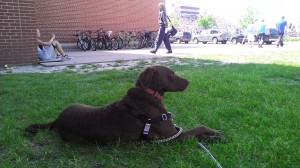
For physical fears such as skateboards and bicycles, I ask a friend to ride their bike past us at a safe distance. As the bicycle approaches, I make sure Louie sees it and then I say “Leave It” and get him to look at me. He knows if he leaves something, he will get a treat. I also use “Look” if I need him to focus on my longer. I want him to look at the trigger and then look at me. It is scarier for him if I don’t let him see and acknowledge the source of the noise. They ride past us staying far away and then they come a little closer each time. The cyclist and I communicate via text messages on the next distance so they never get too close and are aware of when they might need to increase the distance. The nice thing about this is I have total control or at least a lot of a control unless a stranger rides by but typically I can see that and so can my cyclist friend and they will often intercept the cyclist and ask them to be sure and stay the required distance away. Most of the time the stranger is very happy to help.
Once we have done that with some success, I take Louie to an area where I know these triggers are around but make sure there is a safe zone. A safe zone is far enough away that I can retreat if he gets to threshold and hang there to calm him down. I use a large park near the university campus. It has several very large expanses of land with no sidewalks or roads insight so I can move to the middle of the grassy area and regain his attention and calmness. Eventually I can walk him down the street with little to no reaction as long as I am aware, see the cyclist and prepare him and myself for it. I typically tell him to “Leave It” and when he sees the bicycle and then looks at me I treat him.
Special thanks to Trish Neel-Wilson who has provided me with a lot of the information, resources and an enormous amount of guidance through this process with Louie.

